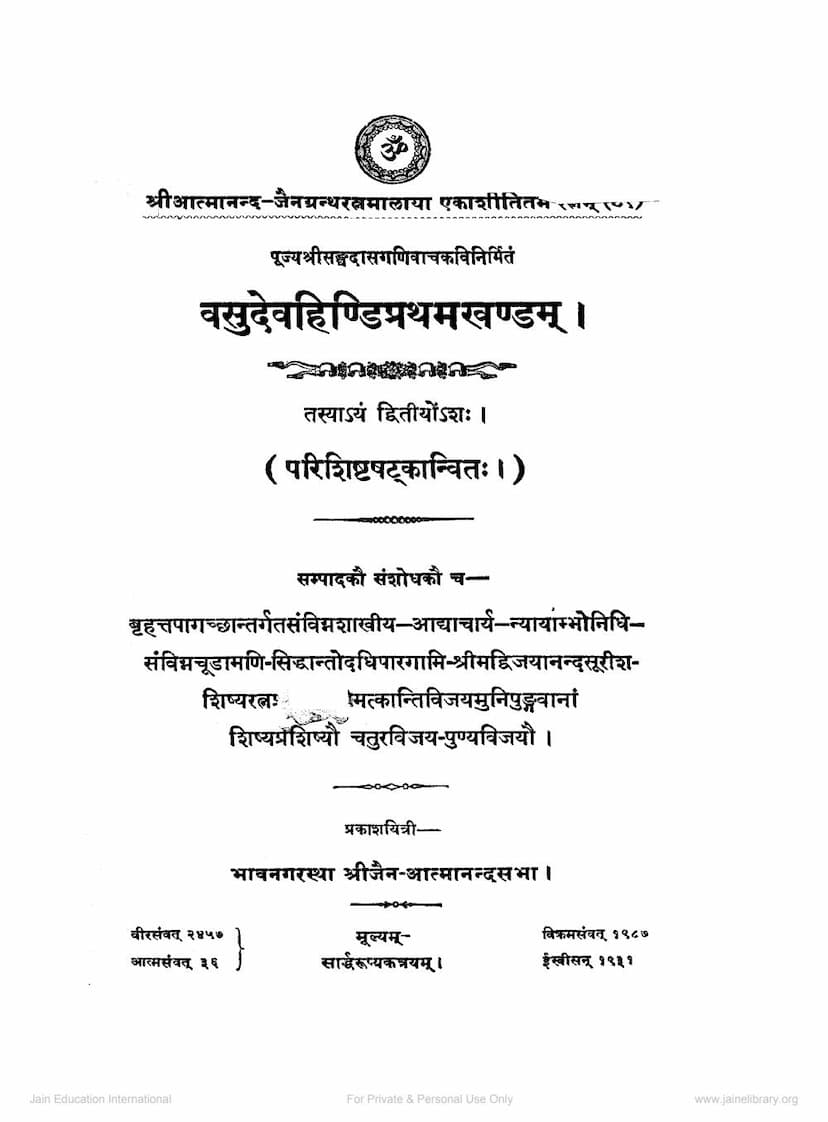Vasudevhindi Part 2
Added to library: September 2, 2025

Summary
Based on the provided text, here is a comprehensive summary of Vasudevhindi Part 2 in English:
Book Title: Vasudevhindi Part 2 Author(s): Sanghdas Gani, Chaturvijay, Punyavijay Publisher: Atmanand Jain Sabha Publication Details: Released in Vir Samvat 2457 (Aatma Samvat 36), Vikram Samvat 1987 (1931 CE). It is the 81st publication of the Shri Atmanand Jain Granthratnamala.
Summary of Vasudevhindi Part 2:
Vasudevhindi Part 2 is the second volume of Sanghdas Gani's significant Jain text, Vasudevhindi. The editors, Muni Chaturvijay and Muni Punyavijay, disciples and grand-disciples of Acharya Shri Vijayanand Surishwarji, have presented this volume with the intention of completing the first part of the original work.
Content of the Volume:
This volume covers chapters 8 through 28 of the Vasudevhindi, detailing the various episodes and journeys of Vasudev and related characters. Specifically, the content includes:
- Chapter 8 (Ahamo Paumaalambho): Describes the story of Vasudev and his encounters, including his relationship with Padmavati.
- Chapter 9 (Navamo Aasasenalambho): Details the story of Asvasena and her marriage to Vasudev.
- Chapter 10 (Dasamo Pundalambho): Recounts the story of Vasudev and Pundali.
- Chapter 11 (Ekkarasamo Rattavatilambho): Focuses on the narrative involving Rattavati.
- Chapter 12 (Barasamo Somisirilambho): Features the story of Somashri and her connection with Vasudev.
- Chapter 13 (Terashamo Vegavatilambho): Narrates the tale of Vegavati and Vasudev's interactions.
- Chapter 14 (Chaudasamo Mayana-vegalambho): Continues with the story of Mayana, her relationship with Vasudev, and the events surrounding her. This chapter also includes extensive discussions on philosophical concepts, particularly the nature of the soul (Atman) and its distinction from the physical elements (Panchabhutas). It also covers the stories of the origin of archery and the philosophical debate on the existence of the soul independent of the body.
- Chapter 15 (Pannarasamo Vegavathilambho): Continues the narrative and likely further elaborates on the character of Vegavati and related events.
- Chapter 16 (Solasamo Balachandalambho): Features the story of Balachanda, likely involving her interactions or relationship with Vasudev.
- Chapter 17 (Sattarasamo Bandhumatilambho): Details the narrative of Bandhumati.
- Chapter 18 (Attharasamo Piyangusundarilambho): Recounts the story of Piyangusundari.
- Chapter 19 (Ekavimsatimo Ketumatilambho): Covers the story of Ketumati and related events. This chapter is particularly noted for its lengthy philosophical discussions, including the concept of karma, the cycle of rebirth, the nature of liberation (Moksha), and the superiority of the Jain path. It also delves into the stories of various characters' previous lives and their karmic connections, such as the complex relationships between Vidudatha, Sanjayanta, and their past lives.
- Chapter 20 (Vāpūsaṁhabhūmī): This chapter seems to focus on the stories of characters like Meharatha, Dhanmilla, and the philosophical discourse on karma and rebirth presented by the ascetic Meharatha.
- Chapter 21 (Kethumatilambho): This chapter appears to cover the narratives involving Kethumati, including her lineage and the stories of various characters like Vasudeva, Manasa, Balachanda, and the philosophical discussions presented by the Arhat Kethumati.
- Chapter 22 (Pabhamatilambho): This section details the story of Pabhamati, her previous lives, and philosophical teachings presented by the ascetic Vasudeva.
- Chapter 23 (Bhaddmitta-Saccharakshiyalambho): Features the stories of Bhaddmitta and Saccharakshiya, likely involving their encounters and philosophical teachings.
- Chapter 24 (Padmavatilambho): This chapter recounts the story of Padmavati.
- Chapter 25 (Padmasarilambho): Details the narrative of Padmasari and her story.
- Chapter 26 (Lalitasirīlambho): Features the story of Lalitasri.
- Chapter 27 (Rohiṇīlambho): Narrates the tale of Rohini.
- Chapter 28 (Devakīlambho): Covers the story of Devaki.
Appendices:
This volume includes six appendices, providing valuable supplementary information:
- Appendix 1: Introduces the wives of Dhummilla and Vasudeva.
- Appendix 2: Lists the sequence of verses found in the first volume of Vasudevhindi.
- Appendix 3: Provides an alphabetical index of special names mentioned in the text.
- Appendix 4: Offers a classified index of these special names.
- Appendix 5: Lists the stories, characters, and examples included in the first volume.
- Appendix 6: Notes specific places mentioned in the first volume, such as Archika.
Editorial Approach:
The editors emphasize the meticulous care taken by both the guru and disciples during the revision process. They humbly request readers to point out any errors found, assuring that such contributions will be gratefully acknowledged and incorporated into the third volume. The volume concludes with an expression of hope for the prompt publication of the third part, which will contain the preface, introduction, thematic index, glossary, and other essential elements.
Overall Significance:
Vasudevhindi is considered a monumental work in Jain literature, renowned for its detailed narratives, philosophical depth, and rich vocabulary. This second part continues to explore the life and teachings of Vasudev and other significant figures, offering insights into Jain dharma, ethics, and cosmology through captivating stories and dialogues.